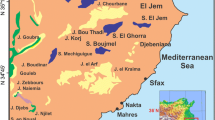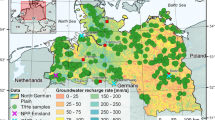Abstract
The Arctic regions are characterized by widespread development of permafrost. We studied a sandy aquifer used for water supply in the talik zone of the Pechora River valley. It has been found that groundwater has TDS values from 75 mg/L far from the river bank to 200 mg/L in the coastal zone. This indicates a predominantly atmospheric recharge of groundwater far from the river and the significant contribution of river water in the composition of groundwater in the coastal zone. The 3H age of groundwater in onshore wells was 20–25 years, on the basis of which it was concluded that the groundwater entering the aquifer before 1995–2000 was almost completely replaced. Mean water residence time, sampled from wells far from the river bank, ranges from 20 to 50 years. However, unlike onshore wells, this groundwater contains “bomb water” and old water that entered the aquifer before 1952. The age of the old water reaches 12.9 ± 2.5 ka. The use of information on the distribution of tritium isotopes made it possible to clarify the conditions of groundwater recharge and end-member ratios of young water, “bomb water” and old water in different parts of the aquifer.










Similar content being viewed by others
Availability of data and materials (data transparency)
The author declares data transparency.
References
Alvarado C, Purtschert JAR, Barbecot F et al (2007) Constraining the age distribution of highly mixed groundwater using 39Ar: A multiple environmental tracer (3H/3He, 85Kr, 39Ar, and 14C) study in the semiconfined Fontainebleau Sands Aquifer (France). Water Resour Res 43:W03427. https://doi.org/10.1029/2006WR005096
Alvarado C, Barbecot F, Purtschert JAR (2009) Ambient vertical flow in long-screen wells: a case study in the Fontainebleau Sands Aquifer (France). Hydrogeol J 17:425–431. https://doi.org/10.1007/s10040-008-0383-1
Arslanov KhA, Tertychnaya TV, Chernov SB (1993) Problems and Methods of dating of low-activity samples by liquid scintillation counting. Radiocarbon 35:393–398 https://journals.uair.arizona.edu/index.php/radiocarbon/article/view/1586/1590
Aybulatov NA (2000) Ecological Echo of the Cold War in the Seas of the Russian Arctic. GEOS, Moscow (in Russian)
Brubaker M, Berner J, Chavan R, Warren J (2011) Climate change and health effects in Northwest Alaska. Glob Health Action 4:1–5. https://doi.org/10.3402/gha.v4i0.8445
Chebotina MYa, Nikolin OA (2005) Radioecological studies of tritium in the Ural region. Ural Branch of RAS, Yekaterinburg (in Russian)
Cochand M, Molson J, Lemieux J-M (2019) Groundwater hydrogeochemistry in permafrost regions. Permafrost Periglac Process 30(2):90–103. https://doi.org/10.1002/ppp.1998
Eichelberger L (2019) Recognizing the dynamics of household water insecurity in the rapidly changing polar north: Expected uncertainties in access, quality, and consumption patterns in Niugtaq (Newtok), Alaska. World Develop 16:100148. https://doi.org/10.1016/j.wdp.2019.100148
Ferronsky VI, Polyakov VA (2012) Isotopes of the Earth’s Hydrosphere. Springer, Dordrecht, Heidelberg, London, NewYork https://2lib.org/book/2056657/66e617?id=2056657&secret=66e617
Fourré E, Jean-Baptiste Ph, Dapoigny A et al (2006) Past and recent tritium levels in Arctic and Antarctic polar caps. Earth Planet Sci Lett 245(1–2):56–64. https://doi.org/10.1016/j.epsl.2006.03.003)
Fourré E, Landais A, Cauquoin A, Jean-Baptiste P, Lipenkov V, Petit JR (2018) Tritium records to trace stratospheric moisture inputs in Antarctica. J Geophys Res 123:3009–3018. https://doi.org/10.1002/2018JD028304
Fröhlich K (2013) Dating of old groundwater using uranium isotopes – principles and applications. In: Suckow A, Aggarwal PK, Araguas-Araguas L (eds) Isotope methods for dating old groundwater. IAEA, Vienna pp 153–178 https://www-pub.iaea.org/MTCD/Publications/PDF/Pub1587_web.pdf
Gwynn JP, Dowdall M, Davids C et al (2004) The radiological environment of Svalbard. Polar Res 23(2):167–180. https://doi.org/10.3402/polar.v23i2.6277
Han L-F, Plummer N (2013) Revision of Fontes and Garnier’s model for the initial 14C content of dissolved inorganic carbon used in groundwater dating. Chem Geol 351:105–114
Han L-F, Plummer N (2016) A review of single-sample-based models and other approaches for radiocarbon dating of dissolved inorganic carbon in groundwater. Earth-Sci Rev 152:119–142
Han L-F, Plummer LN, Aggarwal P (2012) A graphical method to evaluate predominant geochemical processes occurring in groundwater systems for radiocarbon dating. Chem Geol 318–319:88–112
Han L-F, Plummer LN, Aggarwal P (2014) The curved 14C vs. δ13C relationship in dissolved inorganic carbon: A useful tool for groundwater age- and geochemical interpretations. Chem Geol 387:111–125
Ingerson E, Pearson Jr FJ (1964) Estimation of age and rate of motion of groundwater by the14C method. Recent Researches in the fields of Hydrosphere, Atmosphere and Nuclear Chemistry 263–283
Jyrkama MI, Sykes JF (2007) The impact of climate change on spatially varying groundwater recharge in the grand river watershed (Ontario). J Hydrol 338(3–4):237–250. https://doi.org/10.1016/j.jhydrol.2007.02.036
Kløve B, Ala-Aho P, Bertrand G et al (2014) Climate change impacts on groundwater and dependent ecosystems. J Hydrol 518:250–266. https://doi.org/10.1016/j.jhydrol.2013.06.037
Kralik M (2015) How to estimate mean residence times of groundwater. Procedia Earth Planet Sci 13:301–306. https://doi.org/10.1016/j.proeps.2015.07.070
Lal D, Peters B (1967) Cosmic Ray Produced Radioactivity on the Earth. In: Sitte K (ed) Kosmische Strahlung II / Cosmic Rays II. Handbuch der Physik / Encyclopedia of Physics, vol 9 / 46 / 2. Springer, Berlin, Heidelberg pp 551–612 https://doi.org/10.1007/978-3-642-46079-1-7
Logachev VA (ed) (2005) Modern radioecological stop in the places of peaceful nuclear explosions on the territory of the Russian Federation. IzdAT, Moscow (in Russian)
Lucas LL, Unterweger MP (2000) Comprehensive review and critical evaluation of the half-life of tritium. J Res Nat Inst Stand Technol 105(4):541–549. https://doi.org/10.6028/jres.105.043
Malov AI (2018a) Evolution of the groundwater chemistry in the coastal aquifers of the south-eastern White Sea area (NW Russia) using 14C and 234U–238U dating. Sci Total Environ 616–617:1208–1223. https://doi.org/10.1016/j.scitotenv.2017.10.197
Malov AI (2018b) Study of isotopes of carbon, thorium, and uranium in travertine and thermal spring samples: implications for effects of changes in geochemical environment and processes. Isot Environ Health Stud 54(1):78–88. https://doi.org/10.1080/10256016.2017.1342641
Malov AI, Kiselev GP (2008) Uranium in groundwater of the Mezen syneclise. Publishing house of the UB RAS, Ekaterinburg (in Russian)
Malov AI, Rudik GP (2005) Report on the results of work on additional geological study and operational exploration of the “Ozerny” site of the Naryan-Mars groundwater deposit. Technoecology LLC, Arkhangelsk (in Russian)
Malyshev VI, Bakhur AE, Manuylova LI et al (1999) Methods for measuring the volumetric activity of uranium isotopes (234, 238) in natural water sample alpha spectrometry with radiochemical separation. RIMR, Moskow (in Russian)
Maskov MI, Gaidamanchuk AS (1978) Report on the results of the search for groundwater for the water supply of the city of Naryan-Mar. State Enterprise Arkhangelskgeologiya, Arkhangelsk (in Russian)
Maskov MI, Gaidamanchuk AS (1979) Report on the results of the exploration of the "Ozerny" site of the Naryan-Mars groundwater deposit. Arkhangelskgeologiya, Arkhangelsk (in Russian)
Matishov GG, Kasatkina NE, Leppanen AP et al (2011a) New data on the concentration of plutonium isotopes in the sediments of the Barents Sea. Dokl Earth Sc 440:1445–1448. https://doi.org/10.1134/S1028334X11100151
Matishov GG, Matishov DG, Usyagina IS et al (2011b) Assessment of 137Cs and 90Sr fluxes in the Barents Sea. Dokl Earth Sc 439:1190–1195. https://doi.org/10.1134/S1028334X11080265
Matishov GG, Kasatkina NE, Usyagina IS (2019) Technogenic radioactivity of waters in the central arctic basin and adjacent water areas. Dokl Earth Sc 485:288–292. https://doi.org/10.1134/S1028334X19030073
Michel FA, Van Everdingen RO (1994) Changes in hydrogeologic regimes in permafrost regions due to climatic change. Permafrost Periglac Process 5(3):191–195
Minkin EL (1967) Hydrogeological calculations to identify the zones of sanitary protection of groundwater intakes. Nedra, Moscow (in Russian)
Miroshnikov AY, Laverov NP, Chernov RA et al (2017) Radioecological investigations on the Northern Novaya Zemlya Archipelago. Oceanology 57:204–214. https://doi.org/10.1134/S000143701701009X
Mook WG (1976) The dissolution-exchange model for dating groundwater with 14C. In: Interpretation of Environmental Isotope and Hydrochemical Data in Groundwater Hydrology. IAEA: Vienna pp 213–225
Münnich KO (1957) Messungen des 14C-Gehaltes von hartem Grundwasser. Naturwissenschaften 44:32–34
Münnich KO (1968) Isotopendatierung von Grundwasser. Naturwissenschaften 55:3–11
Nygren M, Giese M, Kløve B et al (2020) Changes in seasonality of groundwater level fluctuations in a temperate-cold climate transition zone. J Hydrol X 8:100062. https://doi.org/10.1016/j.hydroa.2020.100062
Okkonen J, Klove B (2011) A sequential modelling approach to assess groundwater–surface water resources in a snow dominated region of Finland. J Hydrol 411(1–2):91–107. https://doi.org/10.1016/j.jhydrol.2011.09.038
Rachkova NG, Shuktomova II (2010) Uranium distribution in aquatic ecosystem components of the pechora river basin. Equipment and News of the Radiation Measurement 2:44–49
Radiation safety standards (NRB-99) (1999) Hygienic standards. Center for Sanitary and Epidemiological Regulation, Hygienic Certification and Expertise of the Ministry of Health of Russia, Moscow (in Russian)
Reimer P, Austin WEN, Bard E et al (2020) The IntCal20 Northern Hemisphere radiocarbon age calibration curve (0–55 cal kBP). Radiocarbon. https://doi.org/10.1017/RDC.2020.41
Roether W (1967) Estimating the tritium input to groundwater from wine samples: groundwater and direct run-off contribution to central European Surface Waters. Isotopes in Hydrology, IAEA-SM-83/7. IAEA, Vienna, pp 73–91
Romanov VV, Ferronsky VI, Vakulovsky SM et al (1983) Tritium content in surface waters of the USSR in 1979–1980. Water Resour 3:109–121
Salminen R, Chekushin V, Tenhola M et al (2004) Geochemical atlas of the Eastern Barents region. Elsevier, Amsterdam
Schell WR, Gauzay G, Payne WR (1974) World distribution of environmental tritium. In: Physical Behaviour of Radioactive Contaminants in the Atmosphere. IAEA, Vienna pp 375–395
Schoeller H (1967) Qualitative evaluation of groundwater resources. In: Methods and techniques of groundwater investigation and development. Water Res. UNESCO, Paris 33:44–52
Schoeller H (1977) Geochemistry of groundwater. In: Groundwater studies - an international guide for research and practice. UNESCO, Paris 15:1–18
Scibek J, Allen DM, Cannon AJ, Whitfield PH (2007) Groundwater–surface water interaction under scenarios of climate change using a high-resolution transient groundwater model. J Hydrol 333(2–4):165–181. https://doi.org/10.1016/j.jhydrol.2006.08.005
Shershakov VM, Bulgakov VG, Kryshev II, Vakulovsky SM, Katkova MN, Kryshev AI (2020) The radiation situation on the territory of Russia and neighboring states in 2019. Ministry of Natural Resources, Roshydromet, "NPO Typhoon", Obninsk (in Russian) https://www.rpatyphoon.ru/upload/medialibrary/187/ezhegodnik_ro_2019.pdf
Shvartsev SL (2004) Soda waters as a mirror of contradictions in modern hydrogeochemistry. In: Fundamental problems of modern hydrogeochemistry. Sci Technol Publ House, Tomsk pp 70–75 (in Russian)
Stuiver M, Reimer PJ, Reimer RW (2021) CALIB 8.2 [WWW program] at http://calib.org, Accessed 16 Feb 2021
Thatcher LL, Payne BR (1965) The distribution of tritium in precipitation over continents and its significance to groundwater dating. In: Proc 6th Intl Conf Radiocarbon and Tritium Dating. Pullman, Washington pp 604–629
Vasiliev AP, Vodolaga BK, Voloshin NP (2005) State program “Nuclear explosions for the national economy” and VNIITF. Bull Atomic Energy 4:20–24 (in Russian) http://elib.biblioatom.ru/text/byulleten-atomnoy-energii_2005_v4/go,18/
Wu H, Wang L, Liu L et al (2019) Groundwater recharge and evolution in the Wuwei Basin, northwestern China. Environ Earth Sci 78:366. https://doi.org/10.1007/s12665-019-8362-5
Yakovlev EYu, Puchkov AV (2020) Assessment of current natural and anthropogenic radionuclide activity concentrations in the bottom sediments from the Barents Sea. Mar Pollut Bull 160:111571. https://doi.org/10.1016/j.marpolbul.2020.111571
Acknowledgements
This work was supported by the Russian Ministry of Education and Science (project no. AAAA-A19-119011890018-3), and by the Russian Foundation for Basic Research (projects no. 20-05-00045_A).
Funding
This work was supported by the Russian Ministry of Education and Science (project no. AAAA-A19-119011890018–3), and by the Russian Foundation for Basic Research (projects no. 2005-00045_A).
Author information
Authors and Affiliations
Contributions
Not applicable.
Corresponding author
Ethics declarations
Conflict of interest
The author declares that he does not have competing financial interests or personal relationships that could have appeared to influence the work reported in this paper.
Code availability (software application or custom code)
Not applicable.
Additional declarations for articles in life science journals that report the results of studies involving humans and/or animals
Not applicable.
Ethics approval (include appropriate approvals or waivers)
The author declares ethics approval.
Consent to participate (include appropriate statements)
Not applicable.
Consent for publication (include appropriate statements)
The author declares consent for publication.
Additional information
Publisher's Note
Springer Nature remains neutral with regard to jurisdictional claims in published maps and institutional affiliations.
Supplementary Information
Below is the link to the electronic supplementary material.
Rights and permissions
About this article
Cite this article
Malov, A.I. Tritium records to trace groundwater recharge and mixing in the western Russian Arctic. Environ Earth Sci 80, 583 (2021). https://doi.org/10.1007/s12665-021-09893-z
Received:
Accepted:
Published:
DOI: https://doi.org/10.1007/s12665-021-09893-z




